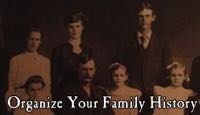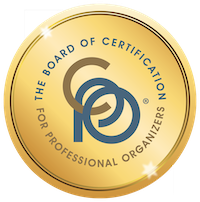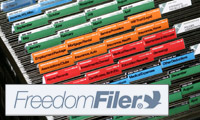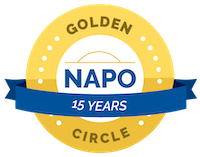A simpler way to file paid bills
I’m in Salt Lake City attending a genealogy conference. Last night I had dinner in the hotel and struck up a conversation with a woman sitting near me at the bar. Naturally, we started talking about organizing (as one does at bars) and she confessed that her biggest challenge was staying on top of the filing. I suggested that she file her paid bills by month and she found that suggestion revelatory! This morning, I thought I’d blog about it, because it had such an impact on her. A quick search revealed I’d done just that on October 24, 2011. So rather than reinvent the wheel, I decided to repeat that post. Here it is, as relevant as ever.
Do you hang on to the paper bills that your creditors send you after you pay them? (Do you even receive your bills in the mail anymore?) A certain percentage of my clients have either gone paperless or automatically shred the bills after paying.
But a larger number of clients (and my family as well) receive most of their bills in the mail and hang on to the paid bills for at least awhile. Most of those clients, at the time I meet them, are doing what I used to do: they’re filing the paid bills by payee. (All the electric bills together, all the credit-card bills together, etc.) Or, more accurately, they’re letting the paid bills pile up because it’s such a pain to file them by payee. (I used to do that, too!)
What I recommend — and I got this idea from Freedom Filer — is instead of filing paid bills by payee, file them by month paid. Freedom Filer has labels for odd year and even year months, which allows you to keep a two-year backlog. (That’s what I do.) But a one-year backlog for non-tax-related documents is almost certainly sufficient.
Here’s what you do:
- Label a dozen hanging file folders, one for each month of the year.
- Create another hanging file folder (or folders) for tax-related documents.
- When you pay bills, separate out any that can serve as documentation for a tax deduction. (This is particularly important for those of us who write off home offices.) Put those in the tax file.
- Drop the rest of the papers in the file corresponding to the month in which you’re paying them.
- After you’ve done this for a year, you’ll find the monthly file full of last year’s bills when you go to file. Simply pull out the contents and shred them. Drop the current month’s bills into the file, where they’ll stay for a year.
It’s that simple! I also put my receipts (again, non-tax-related) in the monthly files, as well as bank statements from my husband’s and my joint checking account. I’ve been doing this four about four years now and have yet to have it cause any problems. I so very rarely need to find anything in the files, but when I do it’s not difficult to find.
One note about tax-related documents: If you don’t keep track of your expenses electronically, you might want to create a series of category-related tax files to make it easier at tax time. Or just do a big sort at tax time.
This method of filing paid bills is so much less time consuming than filing by payee that the “To File” pile becomes a thing of the past. If you’re hanging on to your paid bills, I urge you to give it a try.
Worth repeating: You can learn to be organized
I wrote the post below in June 2013. Reading that yearbook inscription still cracks me up. And makes me proud that I’ve learned to be organized.
Some people are born organized. I know a lot of folks like that, since I hang around with professional organizers. Other people weren’t born organized, but they’ve learned to be organized.
I’m living proof that you can learn to be organized. Let me tell you a little story.
In May, I was contacted on Facebook by one of my high school teachers. He’d been the advisor to the school newspaper. My senior year I was the editor of the school newspaper. Being in touch with him made me pull out my yearbook (which at my high school we called an “annual”).
I turned to the page in the yearbook that featured the school newspaper staff. There we were, sitting around our typewriters. Next to a picture I was in, my teacher had written the following:
Janine, thank you for helping me make it through my first year as Journal advisor. I don’t think I helped you to be any more organized or any neater—but I tried!
That cracked me up when I read it. I don’t actually have any recollection of being particularly disorganized or messy in high school, but it was apparently my defining characteristic, as far as this teacher was concerned.
Through the years, I didn’t let my messiness get in the way of my success. I read and read about organizing techniques and managed to teach myself to be organized. (All along, I was organized in my mind…it was the physical manifestation that was out of kilter.)
When I got burned out as a freelance writer back in 2005, I decided it was time to teach others what I’d learned about getting organized. And now, I make a nice living doing that.
So I went from being an apparently disorganized and messy high school student to being a professional organizer who’s helped hundreds of people get organized. If I can get that organized, so can you.
Don’t think that just because you’re not organized now, you never can be. If you’re dealing with a lot of clutter, the first step is getting rid of the backlog. Once that’s done, it’s a matter of setting up systems that work for the way you think and then creating new habits and routines to help you stay organized.
If you set your mind to it, you can learn to be organized!
Getting a ring off a swollen finger
On the evening of December 3, 2014 I fell and broke my wrist, though I didn’t know immediately that it was fractured. That night, I took my engagement ring off, but my wedding wasn’t moving and I (stupidly) left it on.
The next morning, I went to urgent care and had the wrist x-rayed. For whatever reason, the urgent care doctor and nurse were unconcerned about my ring.
The following day, I left to supervise a three-day move-in for a client in Cape Girardeau, Missouri. (A couple of hours from St. Louis.) Thankfully, my wonderful team made my injured wrist irrelevant to the success of our job. But it really hurt that first day. And part of the reason for the pain was that my finger was swelling around my ring.
I was really fortunate because the husband of the couple we were moving is Dr. Andrew Trueblood, a hand surgeon with Advanced Orthopedic Specialists in Cape Girardeau. When he came home from work at the end of that first day, he took one look at my hand and rewrapped the bandage around the splint, which provided some instant relief. Then he said, “We have to get that ring off.”
Here’s a photo of my rewrapped wrist, showing how the wedding band was squeezing the life out of my finger.

For a half hour, he worked on getting my ring off, telling me that if we weren’t successful it would have to be cut off. I really didn’t want to have my precious ring cut off. It’s a family heirloom: My great grandmother, Alice Jeffries, wore it for 70 years. And I’ve worn it for another 25.
Andrew’s efforts paid off, and I am so grateful for his skill and attention. I wanted to share here the technique he used, in case you ever find yourself in need of getting a ring off your finger
Step one: Wrap the finger in dental floss.
Over and over Andrew wrapped and rewrapped my finger with dental floss so it looked like a mummy. He said this would reduce the swelling. He did it for probably 25 minutes.
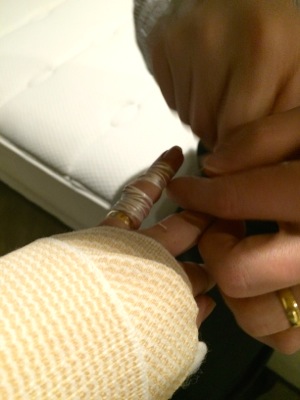
Step two: Get the dental floss under the ring
Since Andrew’s house was still packed (the movers had just brought their stuff to the new house), his access to tools was limited. After he unwrapped my finger for the last time, he patiently used the tines of a plastic fork to ease a strand of floss under the ring, going from of the top of my finger toward my wrist.
Step three: Make the finger slippery
We had some liquid soap on hand, and Andrew soaped up my finger.
Step four: Pull the dental floss
By pulling on the floss and allowing it to go round and round my finger, the ring was slowly eased off. As it was happening, I turned on my phone’s video camera so I could record the last 30 seconds of this miracle. Be sure and watch it to the end to get a glimpse of Andrew.
I am amazed by my good fortune in finding myself in the home of someone who could ease my pain so effectively after this accident. I am grateful to the patience of Andrew and his wife, Amy, and, of course, to my outstanding team that weekend. We got them moved into their gorgeous home without letting a fractured wrist get in the way.
Come learn from a panel of organizers on February 21!
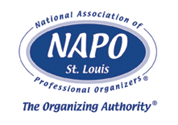
The St. Louis chapter of the National Association of Professional Organizers is putting on a Q&A panel for the public on Saturday, February 21, from 9:30 to 11:30 am. There will be two panels, one comprised of professional organizers and one with associate members of the chapter. (That is, companies that provide products and/or services that complement organizing.)
I’m one of the professional organizer panelists. Here’s the lineup for that panel:
- Janine Adams of Peace of Mind Organizing
- Lisa Bianco of Perfectly Organized STL
- Terry Capehart of Organization in Bloom
- Shelly Collins of Clutter Contained
- Julie Hough of The Ordered Home and
- Sharon Johnson of Fixed Assets LLC
The Professional Organizer panel is being moderated by Shannon Tamme of Shannon Tamme LLC.
Here are the companies being represented on the Associate Member panel:
- Cintrex audio-video conversion
- College Hunks Hauling Junk and College Hunks Moving
- Garage Decor & More
- New Space custom closets and cabinetry
- The File Room document storage and shredding
The Associate Member panel is being moderated by Lisa Gilliam of Six Hour Organizer.
The event is being held at The Lodge Des Peres, 1050 Des Peres Rd, Des Peres, MO 63131.
Please come with all your organizing questions—we’ll be prepared to answer them!
Registration is only $10. For more information and to register, visit the NAPO-St. Louis website.
Packing light is worth the effort
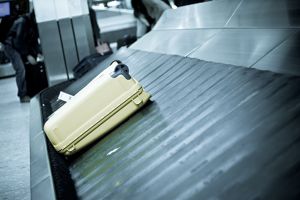
In early December I traveled to Washington state to visit my parents just days after I broke my wrist. I blogged then that I would have to simplify my travel taking the bare minimum number of items so that I could lift my suitcase with one hand. Since I also couldn’t fasten pants with a zipper, the number of clothing items I could take was limited anyway.
I really liked packing light. It had a number of advantages:
- My light suitcase made travel easier
- It was easy to carry my suitcase up the stairs at my host’s house
- Fewer choices for what to wear made dressing easier
- Unpacking took less time
Now I’m planning another trip to visit my parents, which is being tacked on to a trip to a genealogy conference. I’m a convert to packing light, but I also want to look good at my conference. That feels like a much bigger challenge.
I know I can do it, since my wardrobe is comprised of mix-and-match neutral separates (thanks to personal style coaching from my friend, Geralin Thomas). It’s going to take a little more effort as I plan what to pack. It’s much easier to just throw items into a suitcase just in case I might need them. But doing some planning and mindful packing before I leave will make my entire trip easier.
It seems ironic to me that packing light is can be more work than packing heavy. But I think it’s worth the effort.
Photo by Camilo Rueda Lopez via Flickr.
An empty drawer is a beautiful thing
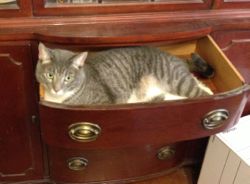
My team and I helped a client declutter and organize her entire home last week and we were able to make a huge impact—because the client parted with so much. She was so ready to let go of the excess that was weighing her down and she made amazing decisions. As we took out bag after bag of donatable items, the rooms seemed to get lighter.
All the team members—and the client—were practically giddy over it.
When it came time to organize the items that were kept, it was a breeze. We found ourselves with empty drawers and even an empty cabinet when we were finished. Folks, that’s a rarity. And it’s a great thing.
To me, an empty drawer represents abundance (though it may appear the opposite). It represents the ability to bring in new items, new ideas, new opportunities. By letting go of so much, this client has opened herself up to a whole new way of life. She’ll no longer have to struggle to find what she needs. Everything in her home has a place (another rarity). Possibilities have opened up.
I have every confidence that she’ll be able to maintain the order. If she has difficulty, she now has a resource (me) to get her right back on track.
I’ve said it before and I’ll say it again, the less stuff you own, the easier life is.
If you have more items than you can store comfortably and the excess is getting in your way, consider letting stuff go. I promise that living in your home will become less of a struggle. And who doesn’t want that?
Worth repeating: Ten minutes to calm
I wrote this post a year ago, but the scenario has been repeated here many times. Taking just ten minutes to put stuff away and tidy up can have powerful results!
Yesterday afternoon, I sat down at my cleared-off desk (I’d cleared it because the housecleaner was coming that morning), and proceeded to trash it. I don’t know what happened—I think I was looking for something I’d written down but couldn’t find. Plus I’d probably dumped some stuff on the desk when I came home. (Yikes.)
I eventually found what I was looking for and turned my attention to my computer screen so that I could get some work done, but the stuff remained all over my desk.
I didn’t really need to use my desk’s surface—my work was focused on my computer—but I still couldn’t get anything done. The ideas weren’t flowing. I was distracted by my messy desk.
So after an hour or so of spinning my wheels, I decided to do something about the desktop. Good organizer that I am, I took a before picture. Then I pressed play on a ten-minute playlist iTunes and I started putting stuff away. And throwing stuff away. I made file folders and filed a few papers. I added some items to my task list.
Here’s what happened in just ten minutes:
Messy desk before:
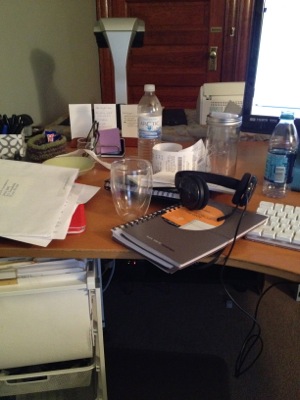
Just ten minutes later:
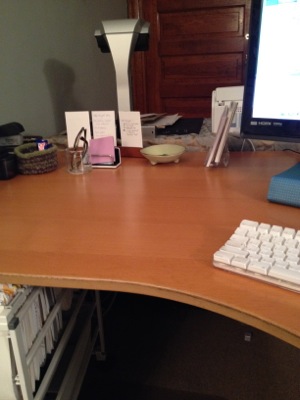
I’m continually impressed with how powerful just a small amount of time decluttering can be. The trick is to pick a small space and finish in the allotted time—don’t leave it half done. The other trick is to do it fairly often; I dealt with yesterday’s clutter so quickly because it was not very deep.
Take a look around the room you’re in. Is there a little space (a shelf? a surface?) that you could declutter this weekend? Trust me, it’ll feel so good.
Search
Recent Posts
- Budgeting and decluttering: It's all about priorities
- Today's truth bomb
- Worth repeating: Labels in the refrigerator
- The meat of my Bullet Journal
- Worth repeating (again): Getting past "I might need it some day"
- Furthering your goals one tiny step at a time
- Repeating spreads in my Bullet Journal
Tags
Links
- National Association of Productivity and Organizing Professionals
- Shannon Wilkinson, life coach
- Are you interested in becoming a professional organizer?
- Ravelry
- Getting to Good Enough podcast
- Organize Your Family History
- NAPO St. Louis
- Peace of Mind Spending
- Institute for Challenging Disorganization

